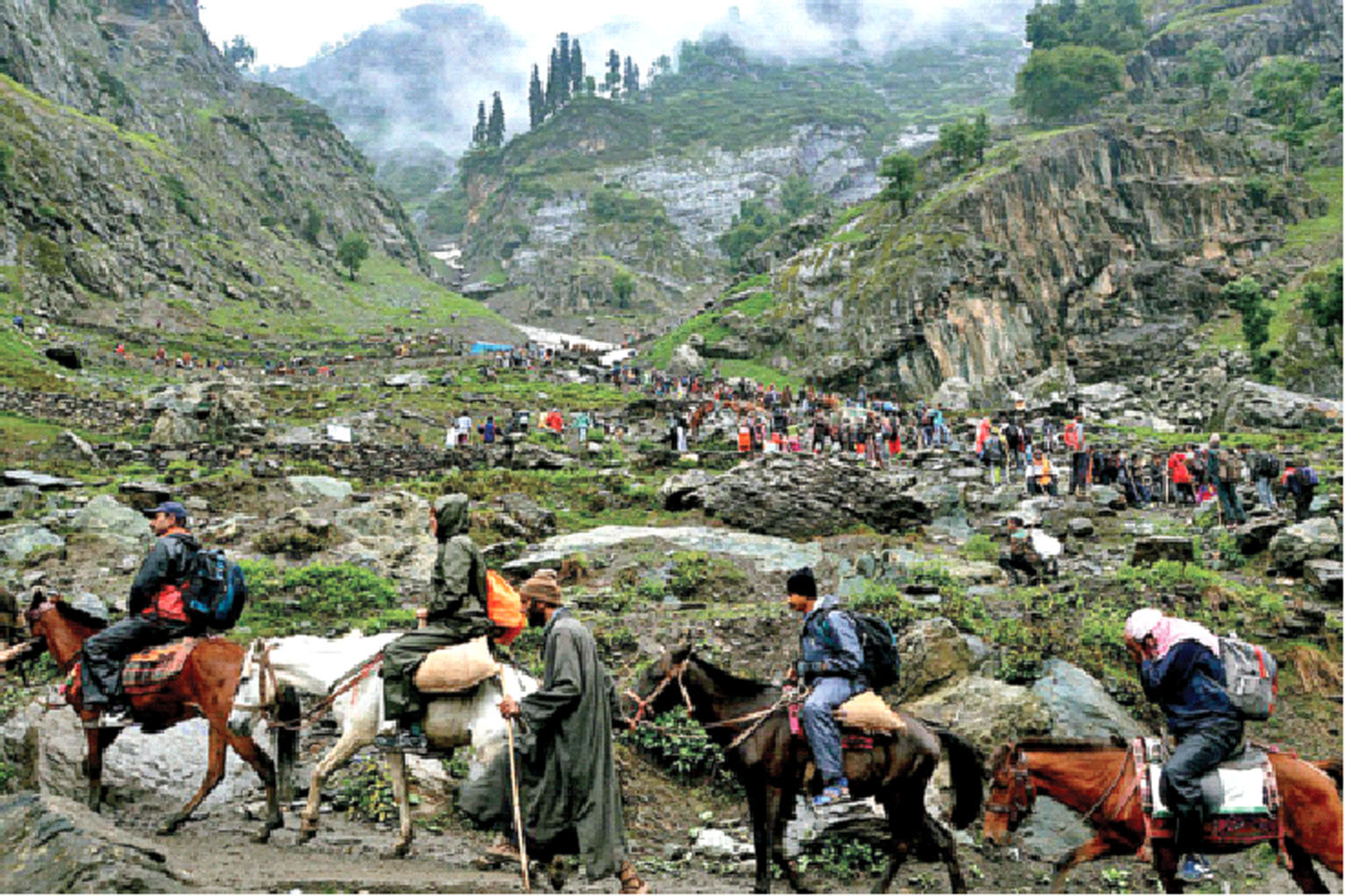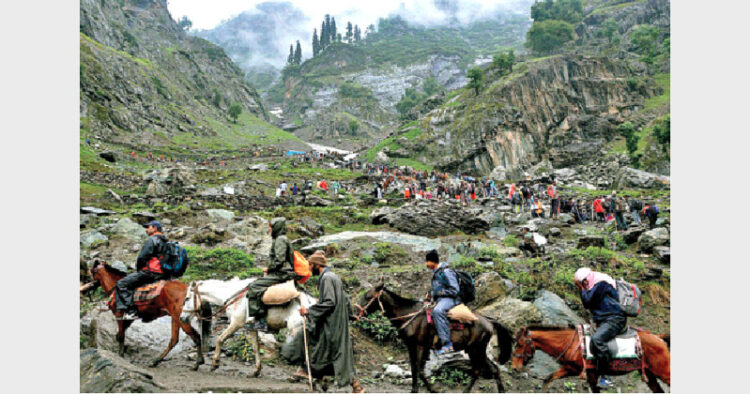 The militants’ attack on the Amarnath pilgrims was a bolt from the blue. It shook the nation. Yet the flow of devotees has continued unabated, thwarting the intents of “jihadis”. The attack, though, has exposed chinks in the security network
The militants’ attack on the Amarnath pilgrims was a bolt from the blue. It shook the nation. Yet the flow of devotees has continued unabated, thwarting the intents of “jihadis”. The attack, though, has exposed chinks in the security network
Deepak Zazia from Pahalgam
Almost two to three lakh pilgrims have been touching the base of Lord Shiva in Amarnath every year in the last five years. And ever since 2002, when militants gunned down nine pilgrims, no untoward incident had taken place. A militant attack on pilgrims after 15 years is a sign of desperation.
Yet pilgrims hardly get discouraged. Not a single pilgrim cancelled his pilgrimage due to the fear of terrorists. In fact, after the militants’ attack the driver of the ill-fated bus Salim said “I would like to take another round up there”.
The ill-fated Gujarat busContrary to the claims of the State Government, the bus from Gujarat that came under terror attack in Anantnag on July 10 had crossed the Lakhanpur toll post — the gateway to Jammu & Kashmir on July 6 and it was “registered” with the Amarnath Tourist Reception Centre, Lakhanpur. |
The message is clear. The jihadis cannot make any dent into the faith and determination of the devouts.
The terrorist attack on pilgrims of Shri Amarnath, after a gap of 15 long years, raises questions about the measures that has been put in place to counter terrorism in Kashmir Valley in general and South Kashmir in particular. This attack has also exposed security arrangements made by the authorities for pilgrims who come from every nook and corner of the country.
|
Disruptive Attempts August 2000: More than 30 Amarnath pilgrims killed when terrorists attacked Pahalgam Base Camp |
Much before June 28, when the first batch of 2,280 pilgrims left Bhagwati Nagar base camp of Jammu for the Yatra, the intelligence agencies had reportedly sounded authorities about “the highest level of threat
perceptions to this year’s pilgrimage”. Keeping that in view, adequate security arrangements were made but terrorists managed to strike still.
|
“Strongly condemn attack on Amarnath Yatris in J & K ; grieve the loss of innocent lives” “Pained beyond words on the dastardly attack on peaceful Amarnath Yatris in J&K. The attack deserves strongest condemnation from everyone. My thoughts are with all those who lost their loved ones in the attack. “An attack on religious freedom is an attack on the most fundamental right of liberty.” “Terrorist attack on Amarnath Yatra is the most reprehensible act. This should add to our determination to eliminate terrorism. This incident should add to our determination to eliminate terrorism.” |
For the first time drones, satellite tracking systems, jammers are being used to monitor tracks as well as base camps of the Yatra from Jammu onwards.
What is more shocking, higher-ups were reportedly aware that terrorists were desperate to attack the Yatra.
S N Shrivastava, Special Director General, CRPF, had said at the commencement of the pilgrimage that the annual yatra was a big challenge and elaborate security was in place to ensure the safety of the pilgrims.
The government had mobilised a heavy security blanket of over 35,000 to 40,000 troops, including the police, the Army, the BSF and the CRPF.
Kashmiriyat gets a beatingKhalid Jehangir |
In addition to the existing strength of the CRPF in the state, the Centre has provided over 250 companies (25,000 personnel) of paramilitary forces to the State government along the two routes-— the traditional 46 kms from Pahalgam in Anantnag district and the shorter 14 kms Baltal track in Ganderbal district.
“This Amarnath yatra will have the highest-ever security setup to ensure an incident-free yatra,” Shrivastava had stated before beginning of the Yatra.
Anti-terror Quick Reaction Teams (QRTs), Mountain Rescue Teams (MRTs) of the State police along with the rescue teams of various security forces are pressed into service along with fire-fighting teams at pre-determined points.
Before commencement of the Yatra, Union Home Minister Rajnath Singh had chaired a security review meeting in which the Union Home Secretary, Director of the Intelligence Bureau, Joint Secretary, Kashmir, and Ministry of Home Affairs (MHA) officials were present.
Despite such adequate arrangements, a group of Laskher-e-Taiba (LeT) terrorists led by one Pakistani terrorist, Abu Ismail, managed to attack the Yatra which claimed lives of seven pilgrims and injured 15 others. This tragedy has raised many questions which cannot be evaded just on the ground that the ill-fated bus targeted by terrorists was not registered.
On July 3, a policeman and a civilian were injured after heavily armed terrorists opened indiscriminate firing on the security team deployed for the Amarnath Yatra security in Anantnag. The attack was a signal to the authorities but they failed to take note of it. This incident had exposed security arrangements but the authorities have failed to gauge seriousness of the situation.
At Betengoo in Anantnag district, where terrorist attacked pilgrims, a police naka was just a few kilometres away. According to reports of the police, within 10 minutes terrorists struck thrice on the ill-fated bus.
The attack occurred at Batengoo at about 8.20 pm when 56 pilgrims were returning from Baltal, one of the base camps for pilgrims, to Jammu. Batengoo is 65 kms south of Srinagar.
The State police, in its report to the Centre said the bus came under fire twice from within a distance of 75 meters from its right side. They also suspect that two groups were involved in the attack. A preliminary inquiry by the security agencies has found that terrorists came on motorcycles.
Hearing the gunshots, an armoured vehicle of the CRPF and the Special Operations Group (SOG) of the Jammu & Kashmir (J&K) police rushed to the spot only to find militants still there and an exchange of fire took place.
The militants then fled towards Arwani village, 1.5 km away, and before disappearing in the bylanes, opened fire on a CRPF camp at Hasanpura.
Who is Abu Ismail?
Before attack on Amarnath Yatra, security forces operating in the Valley have not heard name of Abu Ismail. In the first week of June, an intelligence input claimed that one Abu Ismail, a Pakistani terrorist was moving in a group of four persons in the Pir Panjal range.
It is believed that Pakistani’s ISI had deputed Abu Ismail to strengthen network of pan-Islamic terror group in Kashmir Valley.
According to official sources the intelligence input claimed that Ismail and his group was doing a recoinnsance of targets in the area and moving through villages en route to the Amarnath cave. The official added that there was a possibility that at least two persons in his group were local residents.
Just after the attack, Inspector General of Police (IGP) Kashmir Muneer Khan said that Abu Ismail was one of the masterminds of the attack, which he attributed to the LeT. Earlier, security agencies were aware of the name of Abu Dujana, who is self-proclaimed divisional commander of LeT for South Kashmir. Dujana is also known by the name of Hafiz and is considered to be from Pakistan-occupied-Kashmir (PoK).
During the last one year, South Kashmir is witnessing spurt of violence after killing of Hizbul Mujahideen self-styled commander Burhan Wani.
Last attack on Amarnath Yatra was executed by terrorists in the month of August 2002. During the last 15 years, terrorists and their supporters, who have camouflaged themselves as human right activists and ecologists have started a systematic campaign to instigate people against the Yatra.
After 2002, radical groups started gaining ground in the Valley so repeated attempts were made to dismantle all symbols of Kashmiriyat and composite culture. A systematic and well-organised campaign was launched by radical groups, who camouflaged themselves as social activists and environmentalists, to demonise the Amarnath yatra that symbolises the composite culture of brotherhood and communal harmony in the State.
Not only separatists, some writers, in garb of social activists, started a campaign to rake up peoples’ sentiments against the yatra.
On April 20 this year, a so-called NGO had published a highly provocative report instigating people against the pilgrimage. The report, “Amarnath Yatra: A Militarised Pilgrimage,” was released just before the beginning of the registration of the pilgrims. Its main aim was to rake up sentiment of people against the yatra.
For the past five years, radical leaders, be it Shabir Shah or Sayeed Ali Shah Geelani, have launched a campaign to curtail the yatra’s period and put restrictions on the number of pilgrims.














Comments